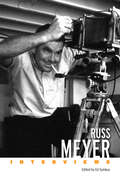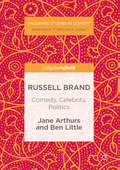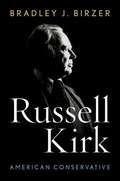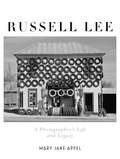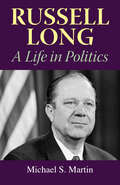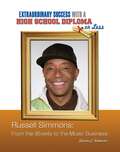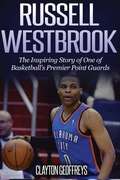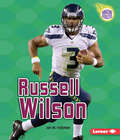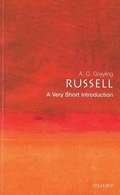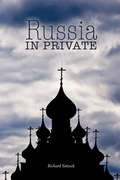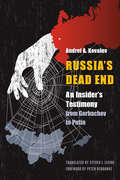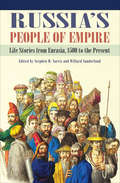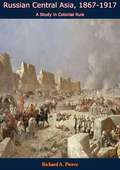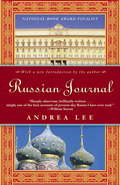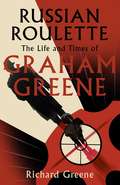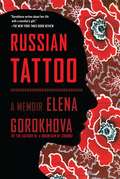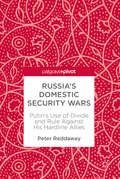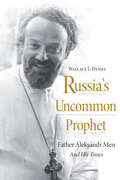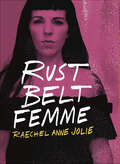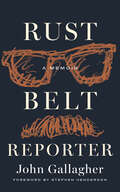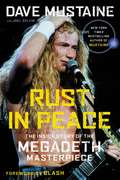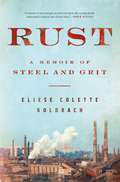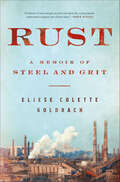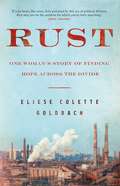- Table View
- List View
Russ Meyer: Interviews (Conversations with Filmmakers Series)
by Ed SymkusRuss Meyer: Interviews offers a detailed look into the mind, life, and successful career of the maverick filmmaker Russ Meyer. Known for his audacious visual style and boundary-pushing content, Meyer (1922–2004) carved out a unique niche in the film industry with his provocative and often controversial works, including Faster, Pussycat! Kill! Kill!; Beyond the Valley of the Dolls; and Vixen! In this volume, Meyer talks over the course of eighteen newspaper and magazine interviews—conducted between the late 1960s and early 1990s—about assignments in still- and motion-picture combat photography during World War II, learning all aspects of the filmmaking craft when he was shooting industrial films after the war, later stumbling into the business of photographing pin-up girls for magazines, and how that segued into his first forays in what would become the sexploitation movie market. Working with small budgets and small crews, Meyer became a skilled director and pitchman for his own work, hitting the road with reels of film in his car, going from town to town, getting them shown in small moviehouses, building an audience, making big profits, then using them to make his next film. The films were expertly photographed, inventively edited, and featured intriguing (and violent, carnal, and funny) storylines, and ticket sales numbers eventually caught the eyes of the Hollywood studio system, for which Meyer briefly worked, before once again striking out on his own with ever-more violent, sexual, and cartoonish features. Meyer made fortunes, he lost fortunes, then he made them again, and he was always game for getting involved in controversy, which was easy due to the content of his films. After his final theatrical feature—Beneath the Valley of the Ultra-Vixens—in 1979, Meyer reinvented himself as an entrepreneur by making his films available on the burgeoning home video market, leaving him a celebrated and very wealthy man.
Russell Brand: Comedy, Celebrity, Politics
by Jane Arthurs Ben LittleRussell Brand is one of the most high profile and controversial celebrities of our time. A divisive figure, his ability to bounce back from adversity is remarkable. This book traces his various career stages through which he has done this, moving from comedy, to TV presenting; from radio to Hollywood films. It identifies how this eclectic career in entertainment both helped and hindered his high-profile move into political activism. Underpinning the book are interviews with leading activists and politicians, and sophisticated readings of Brand's performances, writing and on-screen work. There are sections on the Sachsgate scandal, his Newsnight interview with Jeremy Paxman, and his 2015 election intervention for aspiring Prime Minister Ed Miliband. It builds on scholarly work in the area of celebrity politics to develop an original analytic approach that blends the field theory of Pierre Bourdieu with the assemblage theory of Gilles Deleuze and Felix Guattari.
Russell Kirk: American Conservative
by Bradley J. BirzerEmerging from two decades of the Great Depression and the New Deal and facing the rise of radical ideologies abroad, the American Right seemed beaten, broken, and adrift in the early 1950s. Although conservative luminaries such as T. S. Eliot, William F. Buckley Jr., Leo Strauss, and Eric Voegelin all published important works at this time, none of their writings would match the influence of Russell Kirk's 1953 masterpiece The Conservative Mind. This seminal book became the intellectual touchstone for a reinvigorated movement and began a sea change in Americans' attitudes toward traditionalism.
Russell Lee: A Photographer's Life And Legacy
by Mary Jane AppelRussell Lee, a contemporary of Walker Evans and Dorothea Lange, now emerges from the shadows as one of the most influential documentary photographers in American history. The most prolific photographer of the Great Depression, Russell Lee has never been canonized for his iconic images. With this compulsively readable and definitive biography, historian and archivist Mary Jane Appel finally uncovers Lee’s rebellious life, tracing his journey from blue-blood beginnings to intrepid years of activism and pioneering creativity, through the incredible body of work he left behind. Born in the quintessential turn-of-the-century small town of Ottawa, Illinois, in 1903, Lee grew up in a wealthy family riddled with tragedy. He trained in college to become a chemical engineer, but was quickly drawn to Greenwich Village, where he developed an interest in social change and the arts. In 1935, the charismatic bohemian picked up a camera and a year later walked into the office of Roy Stryker, head of the Historical Section of the Resettlement Administration, later renamed the Farm Security Administration (FSA), setting in motion a new life trajectory. The Historical Section aimed to capture rural poverty and the New Deal programs designed to abolish it. But Stryker imagined a much broader pictorial sourcebook for America, and no one on his legendary team—including Dorothea Lange, Walker Evans, and Gordon Parks, among others—would be more dedicated to reaching this goal than Russell Lee. As Appel demonstrates, Stryker and Lee developed a fascinating symbiotic relationship that resulted in a massive and complex breadth of work. Living out of his car from the fall of 1936 to mid-1942, Lee crisscrossed America’s back roads more than any photographer of his era. During this time, he shot 19,000 negatives that were captioned and printed—more than twice that of any other FSA photographer. He captured arresting images of sweeping dust storms and devastating floods, and chronicled the World War II home front and the last gasp of a small-town America that was inexorably vanishing?all the while focusing prophetically on issues like segregation and climate change, decades before they became national concerns. Meticulously weaving previously uneen letters and diaries, Appel brilliantly reveals why Lee’s profile has remained obscured, while his contemporaries became broadly celebrated. With more than 100 images spread throughout, Russell Lee speaks not only to the complexity of a pioneering documentary photographer’s work but to a seminal American moment captured viscerally like never before.
Russell Long: A Life in Politics
by Michael S. MartinRussell Long (1918-2003) occupies a unique niche in twentieth-century United States history. Born into Louisiana's most influential political family, and son of perhaps the most famous Louisianan of all time, Long extended the political power generated by other members of his family and attained heights of power unknown to his predecessors, including his father, Huey. The Long family and its followers pervaded Louisiana politics from the late 1920s through the 1980s. Being a Long--especially a son of Huey Long--preordained Russell for a political life. His father's assassination set the wheels in motion for his eventual political career. In 1948, Russell followed his father and his mother to a seat in the United States Senate. In due course, he rose to the politically eminent positions of majority whip and chair of the Senate Finance Committee. Russell Long: A Life in Politics examines Long's public life and places it within the context of twentieth-century Louisiana, southern, and national politics. In Louisiana, Long's politics arose out of the Longite/ Anti-Longite period of history. Yet he transcended many of those two groups' factional squabbles. In the national realm, Long's politics exhibited a working philosophy that straddled the boundaries between New Deal liberalism and southern conservatism. By the time of his retirement in early 1987, he had witnessed the demise of one political paradigm--the New Deal liberal consensus--and the creation of one dominated by a new style of conservatism.
Russell Simmons: From the Streets to the Music Business (Extraordinary Success with a High School)
by Shaina C. IndovinoIn the last few decades, more and more people are going to college to further their education. It's hard to become a scientist, a professor, or a businessperson without getting some sort of college degree--but college isn't always necessary to achieve success. Some people are ready to enter the workforce right after high school. Russell Simmons was one of those people. The music mogul began his career promoting parties and concerts for rappers and DJs few people outside of New York City had ever heard of. Today, he's helped to spread hip-hop music and culture around the globe. Few people have changed music and business as much as Russell Simmons. And what's most amazing about his story is that the music business mogul has done it all without a college degree!
Russell Westbrook: The Inspiring Story of One of Basketball's Premier Point Guards
by Clayton GeoffreysNewly revised for the 2017-2018 season, Russell Westbrook: The Inspiring Story of One of Basketball's Premier Point Guards details the inspirational story of basketball's superstar point guard, Russell Westbrook. Russell Westbrook's ascent into the top point guards in the NBA amongst the likes of Chris Paul and Stephen Curry has definitely been a surprise. From once struggling to make his high school varsity team (he did not make it until his junior year) to spending his freshman year at UCLA as a benchwarmer, few would have predicted that Russell Westbrook would be selected as the fourth overall pick in the 2008 NBA Draft. The rest is history as the Oklahoma City Thunder continue their quest for a championship. <P><P> Russell Westbrook is easily one of the most exciting point guards to play the game of basketball. From flashy crossovers to high flying dunks, Russell Westbrook has a bright basketball career ahead of him. When Kevin Durant came down with a foot injury, Russell Westbrook rose as a primary leader for the Oklahoma City Thunder. In the first season since Durant's departure from Oklahoma City, Westbrook again rose to the occasion as he captured the MVP award while putting up forty-two triple doubles in the regular season, a historic record. <P><P> It will be exciting to see how Westbrook and the Thunder do in this year's NBA season as Paul George joins the team. More importantly though, it'll be interesting to see how Westbrook continues to mature as a leader. But don't delay, pick up your copy of Russell Westbrook: The Inspiring Story of One of Basketball's Premier Point Guards today.
Russell Wilson (Amazing Athletes Ser.)
by Jon M FishmanWhen Russell Wilson played for the University of Wisconsin, many people thought he was too short to be a starting quarterback in the National Football League (NFL). But he proved these doubters wrong. This Seattle Seahawks quarterback led his team to victory in his very first season, winning the 2014 Super Bowl. Football fans cheer his passing power and leadership skills. Find out more about Russell's journey to the top.
Russell: A Very Short Introduction
by A. C. GraylingBertrand Russell (1872-1970) is one of the most famous and important philosophers of the twentieth century. In this account of his life and work A.C. Grayling introduces both his technical contributions to logic and philosophy, and his wide-ranging views on education, politics, war, and sexual morality. Russell is credited with being one of the prime movers of Analytic Philosophy, and with having played a part in the revolution in social attitudes witnessed throughout the twentieth-century world. This introduction gives a clear survey of Russell's achievements across their wholerange.
Russia in Private
by Richard YatzeckFrom the very beginning of Russia's history, discord has been prevalent thanks to the ruinous jealousy of the nobles, the Pecheneg and Tatar invasions, and lost wars (or brutally costly victories, as in 1812 or 1945). Autocratic government with serfdom, famine, and gangsterism have been the Russian lot. Two questions: "Who is to blame?" and "What is to be done?", have plagued life in that one-sixth of the world's land surface since its conception, roughly 988 AD. During ten tours of Russia, between 1961 and 1997 (nearly thirty years in all), Richard Yatzeck was generously included in the political, kitchen table conversations concerning these very questions. Public discussion of such matters has never been safe. Russia in Private is an attempt to plumb the abyss between Russian and Western life, and explain how Russians understand and bear their history.
Russia's Dead End: An Insider's Testimony from Gorbachev to Putin
by Steven I. Levine Peter Reddaway Andrei A. KovalevElite-level Soviet politics, privileged access to state secrets, knowledge about machinations inside the Kremlin—such is the environment in which Andrei A. Kovalev lived and worked. In this memoir of his time as a successful diplomat serving in various key capacities and as a member of Mikhail Gorbachev’s staff, Kovalev reveals hard truths about his country as only a perceptive witness can do. In Russia’s Dead End Kovalev shares his intimate knowledge of political activities behind the scenes at the Ministry of Foreign Affairs and the Kremlin before and after the dissolution of the USSR in December 1991, including the Russia of Vladimir Putin. Kovalev analyzes Soviet efforts to comply with international human-rights obligations, the machinations of the KGB, and the link between corrupt oligarchs and state officials. He documents the fall of the USSR, the post-Soviet explosion of state terrorism and propaganda, and offers a nuanced historical explanation of the roots of Russia’s contemporary crisis under Vladimir Putin. This insider’s memoir provides a penetrating analysis of late-Soviet and post-Soviet Russian politics that is pungent, pointed, witty, and accessible. It assesses the current dangerous status of Russian politics and society while illuminating the path to a more just and democratic future.
Russia's People of Empire: Life Stories from Eurasia, 1500 to the Present
by Stephen M. Norris and Willard Sunderland&“A fresh and lively approach to understanding how the various Russian empires have worked.&” —Slavic Review A fundamental dimension of the Russian historical experience has been the diversity of its people and cultures, religions and languages, landscapes and economies. For six centuries this diversity was contained within the sprawling territories of the Russian Empire and the Soviet Union, and it persists today in the entwined states and societies of the former USSR. Russia&’s People of Empire explores this enduring multicultural world through life stories of 31 individuals―famous and obscure, high born and low, men and women―that illuminate the cross-cultural exchanges at work from the late 1500s to post-Soviet Russia. Working on the scale of a single life, these microhistories shed new light on the multicultural character of the Russian Empire, which both shaped individuals&’ lives and in turn was shaped by them. &“[S]tudents of Russian empire would be well served with this work, given its snapshots of diverse imperial milieus and their attendant multicultural dialogues at the personal level.&” —Slavic and East European Journal &“This compilation . . . gives readers a more in-depth, personal understanding of how the inescapable existence of diversity in Russia and the Soviet Union related to everyday life . . . Highly recommended.&” —Choice
Russian Central Asia, 1867-1917: A Study in Colonial Rule
by Richard A. PierceRussian Central Asia is the vast area, half as large as the United States, extending from the Caspian Sea to China, from Siberia to northern Iran. Ever since its conquest by Russia in the nineteenth century this region has been both an asset and a problem—because of its strategic and economic importance and because of its several million Moslem inhabitants, to this day unassimilated and unreconciled to Russian control. This book describes events under Imperial Russian rule, treating the period in the light of the conflict between nineteenth-century concepts “the white man’s burden” and the awakening aspirations of colonial peoples, and as part of the contest between Western imperialism and the Islamic world. It shows the enduring geographic, political, and cultural factors that must be faced by an regime in Central Asia, provides a basis for comparison between the methods and motives of the Imperial Russian colonizers and those of the Soviet regime, and refutes misconceptions regarding Russian colonizing techniques.
Russian Journal
by Andrea Lee“A subtly crafted reflection of both the bleak and golden shadings of Russian life . . . Its tones belong more to the realm of poetry than journalism. ”–The New York Times Book Review At age twenty-five, Andrea Lee joined her husband, a Harvard doctoral candidate in Russian history, for his eight months’ study at Moscow State University and an additional two months in Leningrad. Published to enormous critical acclaim in 1981,Russian Journalis the award-winning author’s penetrating, vivid account of her everyday life as an expatriate in Soviet culture, chronicling her fascinating exchanges with journalists, diplomats, and her Soviet contemporaries. The winner of the Jean Stein Award from the National Academy of Arts and Letters–and the book that launched Lee’s career as a writer–Russian Journal is a beautiful and clear-eyed travel-writing classic. “[Lee] takes us wherever she is, conveying a feeling of place and atmosphere that is the mark of real talent. ” –The Washington Post Book World “A book of very great charm . . . [Lee] records what she saw and heard with unassuming delicacy and exactness. ” –Newsweek From the Trade Paperback edition.
Russian Roulette: 'A brilliant new life of Graham Greene' - Evening Standard
by Richard GreeneProbably the greatest British novelist of his generation, Graham Greene's own story was as strange and compelling as those he told of Pinkie the Mobster, Harry Lime, or the Whisky Priest. A restless traveller, he was a witness to many of the key events of modern history - including the origins of the Vietnam War, the Mau Mau Rebellion, the betrayal of the double-agent Kim Philby, the rise of Fidel Castro, and the guerrilla wars of Central America.Traumatized as a boy and thought a Judas among his schoolmates, Greene tried Russian Roulette and attempted suicide. He suffered from bipolar illness, which caused havoc in his private life as his marriage failed, and one great love after another suffered shipwreck, until in his later years he found constancy in a decidedly unconventional relationship.Often called a Catholic novelist, his works came to explore the no man's land between belief and unbelief. A journalist, an MI6 officer, and an unfailing advocate for human rights, he sought out the inner narratives of war and politics in dozens of troubled places, and yet he distrusted nations and armies, believing that true loyalty was a matter between individuals.A work of wit, insight, and compassion, this new biography of Graham Greene, the first undertaken in a generation, responds to the many thousands of pages of lost letters that have recently come to light and to new memoirs by those who knew him best. It deals sensitively with questions of private life, sex, and mental illness; it gives a thorough accounting for the politics of the places he wrote about; it investigates his involvement with MI6 and the Cambridge five; above all, it follows the growth of a writer whose works changed the lives of millions.
Russian Tattoo: A Memoir
by Elena GorokhovaAn exquisite portrait of mothers and daughters that reaches from Cold War Russia to modern-day New Jersey, from the author of A Mountain of Crumbs--the memoir that "leaves you wanting more" (The Daily Telegraph, UK).In A Mountain of Crumbs Elena Gorokhova describes coming of age behind the Iron Curtain and leaving her mother and her Motherland for a new life in the United States. Now, in Russian Tattoo, Elena learns that the journey of an immigrant is filled with everyday mistakes, small humiliations, and a loss of dignity. Cultural disorientation comes in the form of not knowing how to eat a hamburger, buy a pair of shoes, or catch a bus. But through perseverance and resilience, Elena gradually adapts to her new country. With the simultaneous birth of her daughter and the arrival of her Soviet mother, who comes to the US to help care for her granddaughter and stays for twenty-four years, it becomes the story of a unique balancing act and a family struggle. Russian Tattoo is a poignant memoir of three generations of strong women with very different cultural values, all living under the same roof and battling for control. Themes of separation and loss, grief and struggle, and power and powerlessness run throughout this story of growing understanding and, finally, redemption. "Gorokhova writes about her life with a novelist's gift," says The New York Times, and her latest offering is filled with empathy, insight, and humor.
Russia’s Domestic Security Wars: Putin's Use Of Divide And Rule Against His Hardline Allies
by Peter ReddawayThe book is a case study of Putin’s use of the tactics of divide and rule in relation to, particularly, the hard-line elements among his supporters. It illustrates Putin's methods of staying in power vis-à-vis groups that might put too much pressure on him, or who might even try to oust him. The project also suggests that Putin’s survival tactics have brought Russia to a deeply corrupt, state-dominated form of authoritarianism, which lacks deep institutional roots and will probably lead in due course to some form of state collapse. This work will appeal to a wide audience including political scientists, academics, graduate students, and everyone who is interested in contemporary Russian politics.
Russia’s Uncommon Prophet: Father Aleksandr Men and His Times
by Wallace DanielThis lucidly written biography of Aleksandr Men examines the familial and social context from which Men developed as a Russian Orthodox priest. Wallace Daniel presents a different picture of Russia and the Orthodox Church than the stereotypes found in much of the popular literature. Men offered an alternative to the prescribed ways of thinking imposed by the state and the church. Growing up during the darkest, most oppressive years in the history of the former Soviet Union, he became a parish priest who eschewed fear, who followed Christ's command "to love thy neighbor as thyself," and who attracted large, diverse groups of people in Russian society. How he accomplished those tasks and with what ultimate results are the main themes of this story. Conflict and controversy marked every stage of Men's priesthood. His parish in the vicinity of Moscow attracted the attention of the KGB, especially as it became a haven for members of the intelligentsia. He endured repeated attacks from ultraconservative, anti-Semitic circles inside the Orthodox Church. Fr. Men represented the spiritual vision of an open, non-authoritarian Christianity, and his lectures were extremely popular. He was murdered on September 9, 1990. For years, his work was unavailable in most church bookstores in Russia, and his teachings were excoriated by some both within and outside the church. But his books continue to offer hope to many throughout the world—they have sold millions of copies and are testimony to his continuing relevance and enduring significance. This important biography will appeal to scholars and general readers interested in religion, politics, and global affairs.
Rust Belt Femme
by Raechel Anne JolieAn NPR Best Book: &“[Jolie's] story is both remarkable and utterly ordinary; any dreamy kid who grew up broke and weird will see a spark of themselves.&” ―The New Republic One of NPR&’s Best Books of 2020 Winner, Independent Publisher Awards Gold Medal for LGBTQ+ nonfiction Raechel Anne Jolie&’s early life in a working-class Cleveland exurb was full of race cars, Budweiser-drinking men covered in car grease, and the women who loved them. After her father came home from his third-shift job, took the garbage out to the curb and was hit by a drunk driver, her life changed. Raechel and her mother struggled for money: they were evicted, went days without utilities, and took their trauma out on one another. Raechel escaped to the progressive suburbs of Cleveland Heights, leaving the tractors and ranch-style homes in favor of a city with vintage marquees, music clubs, and people who talked about big ideas. It was the early &’90s, full of Nirvana songs and chokers, flannel shirts and cut-off jean shorts, lesbian witches and local coffee shops. Rust Belt Femme is the story of how these twin foundations―rural Ohio poverty and alternative &’90s culture―made Raechel into who she is today: a queer femme with PTSD and a deep love of the Midwest. &“A sharp coming-of-age portrait.&” ―Kirkus Reviews &“This miraculous little book manages to plumb the depths of poverty, trauma, punk rock, maternal devotion, young love, and queer identity in language that is lyric and precise. I was blown away. You will be too.&” —Steve Almond, New York Times–bestselling author of Truth is the Arrow, Mercy is the Bow
Rust Belt Reporter: A Memoir (Great Lakes Books)
by John GallagherThe decline and resurgence of a storied Midwestern city as seen through the eyes of a seasoned journalist, union activist, and Detroit devotee. Reflecting on his life's work as a reporter, including thirty-two years with the Detroit Free Press, journalist John Gallagher merges memoir with an insider's account of the challenges facing Detroit and other Rust Belt cities, as well as the tensions inside local newsrooms throughout the country. Beginning with Gallagher's first job in 1974 in Chicago, with subsequent stops in Rochester and Syracuse, New York, this witty and exciting chronicle details his experiences behind the scenes, breaking major news stories over the decades that followed. From the early days when reporters called in stories on pay phones to today's revenue-generating affiliate commissions, his memoir serves as a documentary of this turbulent journalistic era. Gallagher's career intersected many notable events, including the troubled Kilpatrick administration, newspaper strikes, the federal bailout of automotive companies, the bankruptcy of Detroit, and the exceptional Grand Bargain struck to save the city—all while noting the increasingly important roles nonprofits and private companies play in city politics and newsrooms, for better and for worse. Alongside sage insight into the difficulties and decline of traditional media, Gallagher's experience and advice inspire hope, often underscoring and celebrating the surprising and happy reinvention of heartland cities like Detroit.
Rust in Peace: The Inside Story of the Megadeth Masterpiece
by Dave MustaineGet a behind-the-scenes look at the making of Megadeth&’s iconic record, Rust in Peace, from the band&’s lead vocalist and guitarist.When Rust in Peace was released in 1990, the future of Megadeth was uncertain. Fresh off their performance at the record-breaking Monsters of Rock festival, and with knockout new albums from Slayer, Anthrax, and Metallica dominating the charts, the pressure to produce a standout statement record was higher than ever.In Rust in Peace: The Inside Story of the Megadeth Masterpiece, the band's lead vocalist and guitarist, Dave Mustaine, gives readers a never-before-seen glimpse into the artistry and insanity that went into making the band's most iconic record. He recounts the arduous task of hiring the band and supporting cast, of managing egos and extracurriculars during the album's ensuing success, and succumbing to the pressures of fame and fortune—which eventually forced the band to break up.And yet, Megadeth's demise was just the beginning; the birth pangs of the record were nothing compared to what came next. Alcohol, drugs, sex, money, power, property, prestige, the lies fed to the band by the industry—and the lies they told each other-threatened to eat away at the band's bond like rust, devouring it until only the music survived.Featuring a foreword by Slash
Rust: A Memoir of Steel and Grit
by Eliese Colette GoldbachELIESE WASN'T SUPPOSED TO BE A STEELWORKER. Raised by staunchly Republican and Catholic parents, Eliese dreamed of escaping Cleveland and achieving greatness in the convent as a nun. Full of promise and burgeoning ideals, she leaves her hometown, but one night her life's course is violently altered. A night that sets her mind reeling and her dreams waning. A cycle of mania and depression sinks in where once there were miracles and prayers, and upon returning home she is diagnosed with mixed-state bipolar disorder. Set on a path she doesn't recognize as her own, Eliese finds herself under the orange flame of Cleveland's notorious steel mill, applying for a job that could be her ticket to regaining stability and salvation. Eliese invites the reader inside the belly of the mill. Steel is the only thing that shines amid the molten iron, towering cranes, and churning mills. Dust settles on everything--on forklifts and hard hats, on men with forgotten hopes and lives cut short by harsh working conditions, on a dismissed blue-collar living and what's left of the American dream. But she discovers solace in the tumultuous world of steel, unearthing a love and a need for her hometown she didn't know existed. This is the story of the humanity Eliese finds in the most unlikely of places and the wisdom that comes from the very things we try to run away from most. A reclamation of roots, Rust is a shining debut memoir of grit and tenacity and the hope that therefore begins to grow. ELIESE COLETTE GOLDBACH was a steelworker at Arcelor-Mittal Cleveland. She received an M.F.A. in nonfiction from the Northeast Ohio Master of Fine Arts program. Her writing has appeared in Ploughshares, Western Humanities Review, Alaska Quarterly Review, McSweeney's Internet Tendency, and The Best American Essays 2017. She received the Ploughshares Emerging Writer's Award and a Walter Rumsey Marvin Grant from the Ohioana Library Association, which is given to a young Ohio writer of promise. She now works at John Carroll University and lives in Cleveland with her husband.
Rust: A Memoir of Steel and Grit
by Eliese Colette Goldbach"Elements of Tara Westover’s Educated... The mill comes to represent something holy to [Eliese] because it is made not of steel but of people."—New York Times Book ReviewOne woman's story of working in the backbreaking steel industry to rebuild her life—but what she uncovers in the mill is much more than molten metal and grueling working conditions. Under the mill's orange flame she finds hope for the unity of America.Steel is the only thing that shines in the belly of the mill...To ArcelorMittal Steel Eliese is known as #6691: Utility Worker, but this was never her dream. Fresh out of college, eager to leave behind her conservative hometown and come to terms with her Christian roots, Eliese found herself applying for a job at the local steel mill. The mill is everything she was trying to escape, but it's also her only shot at financial security in an economically devastated and forgotten part of America. In Rust, Eliese brings the reader inside the belly of the mill and the middle American upbringing that brought her there in the first place. She takes a long and intimate look at her Rust Belt childhood and struggles to reconcile her desire to leave without turning her back on the people she's come to love. The people she sees as the unsung backbone of our nation. Faced with the financial promise of a steelworker’s paycheck, and the very real danger of working in an environment where a steel coil could crush you at any moment or a vat of molten iron could explode because of a single drop of water, Eliese finds unexpected warmth and camaraderie among the gruff men she labors beside each day.Appealing to readers of Hillbilly Elegy and Educated, Rust is a story of the humanity Eliese discovers in the most unlikely and hellish of places, and the hope that therefore begins to grow.
Rust: One woman's story of finding hope across the divide
by Eliese Colette Goldbach''[a] memoir of modern American industrial life, written by the insider who got away - or got away enough to reflect intelligently on where they came from. Think JD Vance's Hillbilly Elegy and even Tara Westover's Educated . . . We could all learn from her example.' New York Times Book ReviewEliese wasn't supposed to be a steelworker. Raised by staunchly Republican and Catholic parents, Eliese dreamed of escaping Cleveland and achieving greatness in the convent as a nun. Full of promise and burgeoning ideals, she leaves her hometown, but one night her life's course is violently altered. A night that sets her mind reeling and her dreams waning. A cycle of mania and depression sinks in where once there were miracles and prayers, and upon returning home she is diagnosed with mixed-state bipolar disorder.Set on a path she doesn't recognize as her own, Eliese finds herself under the orange flame of Cleveland's notorious steel mill, applying for a job that could be her ticket to regaining stability and salvation. In Rust, Eliese invites the reader inside the belly of the mill. Steel is the only thing that shines amid the molten iron, towering cranes, and churning mills. Dust settles on everything - on forklifts and hard hats, on men with forgotten hopes and lives cut short by harsh working conditions, on a dismissed blue-collar living and on what's left of the American dream.But Eliese discovers solace in the tumultuous world of steel, unearthing a love and a need for her hometown she didn't know existed. This is the story of the humanity Eliese finds in the most unlikely of places and the wisdom that comes from the very things we try to run away from most. A reclamation of roots, Rust is a shining debut memoir of grit and tenacity and the hope that therefore begins to grow.
